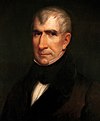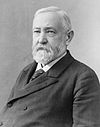Berkeley Plantation
Berkeley Plantation | |
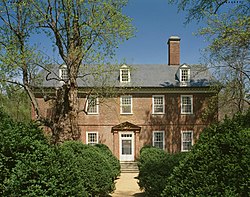 House from the South (river) side | |
| Location | 8 mi. W of Charles City, Charles City County, Virginia |
|---|---|
| Coordinates | 37°19′18″N 77°10′54″W / 37.32167°N 77.18167°W |
| Area | 650 acres (260 ha) |
| Built | 1726 |
| Architectural style | Georgian |
| NRHP reference No. | 71001040[1] |
| VLR No. | 018-0001 |
| Significant dates | |
| Designated NHL | November 11, 1971[3] |
| Designated VLR | July 6, 1971[2] |
Berkeley Plantation, one of the first plantations in America, comprises about 1,000 acres (400 ha) on the banks of the
Among the many American "firsts" that occurred at Berkeley Plantation are:
- In 1619 settlers celebrated the first annual Thanksgiving celebration after landing at Berkeley Hundred.
- In 1862 the Army bugle call "Taps" was first played, by bugler Oliver W. Norton; the melody was written at Harrison's Landing, the plantation's old wharf, by Norton and General Daniel Butterfield.[6]
History
On December 4, 1619, a group of 38 English settlers arrived at
The group's London Company charter required that the day of arrival be observed as a day of thanksgiving to God. On that first day, Captain John Woodlief held a service pursuant to the charter which specified, "Wee ordaine that the day of our ships arrival at the place assigned for plantacon in the land of Virginia shall be yearly and perpetually keept holy as a day of thanksgiving to Almighty God.".[8] Because of this, the Berkeley Plantation had one of the first recorded celebrations of Thanksgiving in the United States.
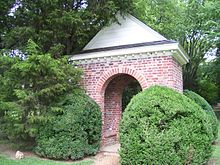
During the
In 1636 William Tucker, Maurice Thompson, George Thompson, William Harris, Thomas Deacon, James Stone, Cornelius Lloyd of London, merchants and Jeremiah Blackman of London, mariner, and their associates and company patented the 8,000 acres known as Berkeley Hundred. After several decades, the site of Berkeley Hundred became the property of
Using bricks fired on the Berkeley plantation,
The first 10 U.S. presidents were on the property enjoying the Harrison family hospitality at some point: George Washington, John Adams, Thomas Jefferson, James Madison, James Monroe, John Quincy Adams, Andrew Jackson, Martin Van Buren, William Henry Harrison (Who was born on the property), and John Tyler who lived nearby are all known to have visited Berkeley.
By the time Benjamin Harrison VII inherited Berkeley in 1799, the land was worn out after more than two centuries of mono-culture tobacco and cotton crops and the plantation was drifting towards financial ruin. After 150 years of Harrison family ownership plantation was foreclosed on by a local bank and the family evicted. Benjamin Harrison VII was the last Harrison to own Berkeley.[10]
During the
Restoration
John Jamieson, a lumber "tycoon" who as a youth had been at Berkeley as a drummer boy in McClellan's army, purchased the property in 1907. In 1925, his son Malcolm inherited the property, expending large sums of money to turn the ruined main house into a livable and stately home for himself and his bride Grace Eggleston. The project took over a decade and the mansion was finally occupied by the Jamisons in 1938.
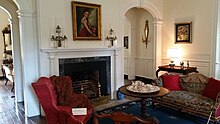
The ground floor of the mansion was turned into a museum in the 1960s. Today the house attracts visitors from the United States and other parts of the world.
The architecture is original, and the house has been filled with antique furniture and furnishings that date from the period when it was built. The grounds, too, have been restored, and cuttings from the boxwood gardens are available as living souvenirs for its visitors. Berkeley is still a working farm; corn, soybeans, wheat, tomatoes, and other vegetables are grown here.
There is also a small family cemetery on the property. Among those buried here are Benjamin Harrison V, Grace Jamieson, and Malcolm Jamieson.[6]
Reconstructed slave quarters were built on the property in 2018 by the producers of Harriet, a movie about Harriet Tubman that was filmed in part at the plantation. The original quarters were no longer extant at that point. Plantation owner Benjamin Harrison V held 110 people in slavery at the time of his death in 1791.[12]
Exterior
The main house is the centerpiece of ten acres of formal gardens and
The house is constructed of red brick with thin mortar joints. The two-story building's main entrance is in the center of the house, with two symmetrical windows on either side and a central window directly above the door. These windows are double sashed with 12 panes per sash. An entablature with dentil moldings support the gabled roof, which is pierced by three dormer windows and two large brick chimneys.
The grounds include a two-story gabled guest house, with symmetrical one-story wings on each side. In 1862, during the
-
Berkeley Plantation guest house
-
Berkeley Plantation guest house
-
Side of the Guest House showing a cannonball from the Battle of the Potomac in 1862.
See also
- List of National Historic Landmarks in Virginia
- National Register of Historic Places listings in Charles City County, Virginia
References
- ^ "National Register Information System". National Register of Historic Places. National Park Service. July 9, 2010.
- ^ "Virginia Landmarks Register". Virginia Department of Historic Resources. Archived from the original on September 21, 2013. Retrieved June 5, 2013.
- ^ "Berkeley Plantation". National Historic Landmark summary listing. National Park Service. Archived from the original on December 11, 2008. Retrieved June 23, 2008.
- ^ ISBN 9780486267517.
- ^ Charles W. Snell (May 1971). "National Register of Historic Places Inventory/Nomination: Berkeley Plantation" (PDF). Virginia Historic Landmarks Commission. Retrieved June 13, 2013. and Accompanying photo
- ^ a b c Roberts, Bruce (1990). Plantation Homes of the James River, pp. 32-35. The University of North Carolina Press.
- ^ Brown, Alexander (1897). The genesis of the United States. Houghton Mifflin. p. 828. Retrieved January 3, 2018.
- ^ "BellaOnline 15545".
- ISBN 978-1-55650-835-6.
- ^ "Berkeley Plantation | HARRISONS".
- ^ "Berkeley Plantation | DRUMMER BOY RETURNS".
- ^ "Berkeley's Enslaved". Berkeley Plantation. Retrieved July 8, 2021.
Further reading
- Masson, Kathryn and Brooke, Steven (photographer); Historic House of Virginia: Great Plantation Houses, Mansions, and Country Places; Rizzoli International Publishing; New York City, New York; 2006
- Dowdey, Clifford; The Great Plantation, A Profile of Berkeley Hundred and Plantation Virginia from Jamestown to Appomattox; Berkeley Plantation; Charles City, Virginia; 1976
External links
- Berkeley Plantation official website
- Virginia's James River Plantations
- James River Plantations, a National Park Service Discover Our Shared Heritage Travel Itinerary
- Berkeley, State Route 5 vicinity, Charles City, Charles City, VA: 35 photos, 7 color transparencies, 16 measured drawings, 4 data pages, and 3 photo caption pages at Historic American Buildings Survey








